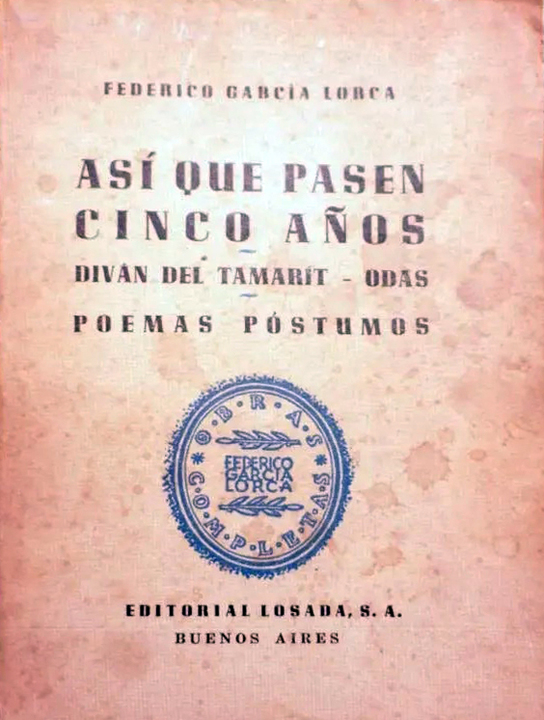Conferences and debates
Index / Activities / Conferences and debates / “The Tamarit Divan”: After 80 years have passed
“The Tamarit Divan”: After 80 years have passed
November 12, 2020
CORDOBA
EVENT POSTPONED UNTIL FURTHER NOTICE.
In Spanish.
EVENT POSTPONED. Casa Árabe is delving into the Lorca’s universe of Arab
culture along Juan Pérez Cubillo, joining the celebration of the
eightieth anniversary of one of the most mysterious works by Federico
García Lorca, the “Diván del Tamarit,” published in its full version in
Buenos Aires by the Losada publishing house under the title “Así que
pasen cinco años” (“After Five Years Have Passed”).
Now that the new opening time restrictions have been enacted by the Autonomous Regional Government of Andalusia, this event has been postponed until further notice. Thank you for your patience.
Federico Garcia Lorca is among the ranks, and to a great extent precedes, the many composers who remind us of our Arabic poetry heritage. More specifically, he shows the mark which this poetry left behind in Granada.
“Gacelas” and ”qasidas” are two types of Arab poetry compositions, grouped into a type of collection or anthology (divan) that alludes to the garden belonging to one of the poet’s cousins, near his own family’s (Tamarit). García Lorca does not follow the same metric scheme, but does use a denomination that made his fortune, in which love, death, longing and frustration are intermingled..., though the twelve gazelles and nine “qasidas” reflect, according to his own words, different variations on the themes of love and death. They are compositions of great beauty, containing hermetic but daring metaphors which do not flee from the constants which appeared throughout his career in poetry.
There have been many interpretations of his work, ever since the famous Arabist Emilio García Gómez decided to publish it in 1934. However, this publication did not actually come out until 1940, once the poet had already died. It is our purpose here to approach the work without overly ornate interpretations which might cause people to feel a distance preventing them from acquiring further knowledge about it.
Juan Pérez Cubillo (Baeza, 1950) studied Romance Philology in Granada and is a retired professor of Language and Literature. The director of the “Luis de Góngora” Institute, he has been the president of the “Elio Antonio de Nebrija” Andalusian Association of Spanish Teachers and the Provincial Coordinator of Andalusian Culture for the Ministry of Education of the Autonomous Regional Government of Andalusia. Pérez Cubillo has taken part in gatherings with Omani writers (BVA) and Moroccan writers (Tetouan), and he has contributed to the newspaper “Córdoba” with flamenco performance and literary critiques, as well as the magazines “Candil,” “La Flamenca” and, in the past, “El Olivo,” along with literary journals (Demófilo, Ficciones, Ánfora Nova, Hesperia, Penélope, La Manzana poética…). Amongst his most notable publications are his studies on Caballero Bonald, on Galician literature (University of Santiago de Compostela), and on Pío Baroja and the city of Cordoba. He also authored José María Alvariño’s edition of “Canciones Morenas” (1987) and co-authored an edition of "Don Quixote of La Mancha" with Juan Rafael Pérez Díaz (Ediciones Aljibe, 2002), as well as other works. In 2010, he published the poetry book “Eironeia: Towards a poetics of disenchantment” and more recently “Lights and Shadows in Cordoba’s Literary Image” (both published by Ediciones Depapel, Cordoba).
Federico Garcia Lorca is among the ranks, and to a great extent precedes, the many composers who remind us of our Arabic poetry heritage. More specifically, he shows the mark which this poetry left behind in Granada.
“Gacelas” and ”qasidas” are two types of Arab poetry compositions, grouped into a type of collection or anthology (divan) that alludes to the garden belonging to one of the poet’s cousins, near his own family’s (Tamarit). García Lorca does not follow the same metric scheme, but does use a denomination that made his fortune, in which love, death, longing and frustration are intermingled..., though the twelve gazelles and nine “qasidas” reflect, according to his own words, different variations on the themes of love and death. They are compositions of great beauty, containing hermetic but daring metaphors which do not flee from the constants which appeared throughout his career in poetry.
There have been many interpretations of his work, ever since the famous Arabist Emilio García Gómez decided to publish it in 1934. However, this publication did not actually come out until 1940, once the poet had already died. It is our purpose here to approach the work without overly ornate interpretations which might cause people to feel a distance preventing them from acquiring further knowledge about it.
Juan Pérez Cubillo (Baeza, 1950) studied Romance Philology in Granada and is a retired professor of Language and Literature. The director of the “Luis de Góngora” Institute, he has been the president of the “Elio Antonio de Nebrija” Andalusian Association of Spanish Teachers and the Provincial Coordinator of Andalusian Culture for the Ministry of Education of the Autonomous Regional Government of Andalusia. Pérez Cubillo has taken part in gatherings with Omani writers (BVA) and Moroccan writers (Tetouan), and he has contributed to the newspaper “Córdoba” with flamenco performance and literary critiques, as well as the magazines “Candil,” “La Flamenca” and, in the past, “El Olivo,” along with literary journals (Demófilo, Ficciones, Ánfora Nova, Hesperia, Penélope, La Manzana poética…). Amongst his most notable publications are his studies on Caballero Bonald, on Galician literature (University of Santiago de Compostela), and on Pío Baroja and the city of Cordoba. He also authored José María Alvariño’s edition of “Canciones Morenas” (1987) and co-authored an edition of "Don Quixote of La Mancha" with Juan Rafael Pérez Díaz (Ediciones Aljibe, 2002), as well as other works. In 2010, he published the poetry book “Eironeia: Towards a poetics of disenchantment” and more recently “Lights and Shadows in Cordoba’s Literary Image” (both published by Ediciones Depapel, Cordoba).

